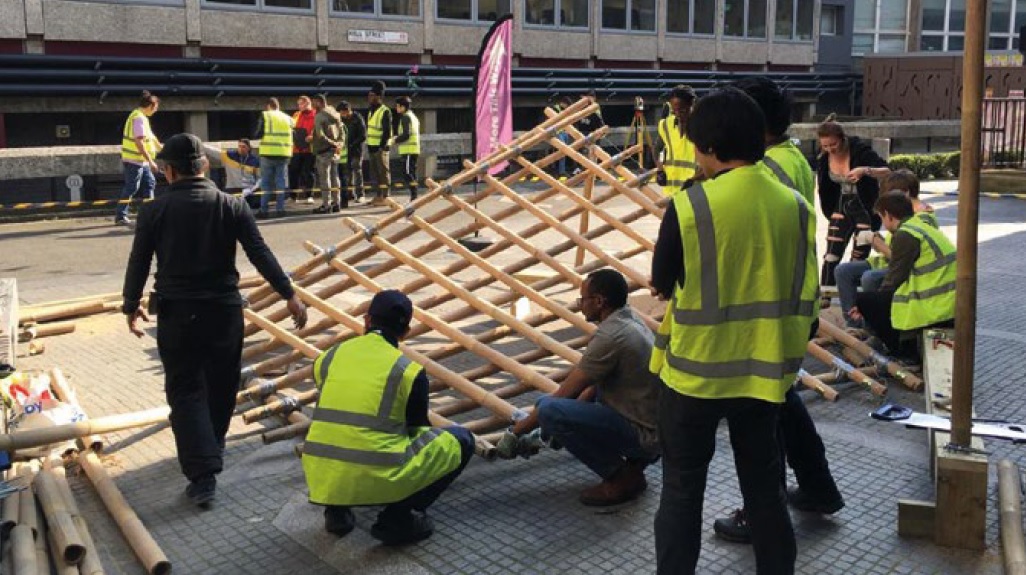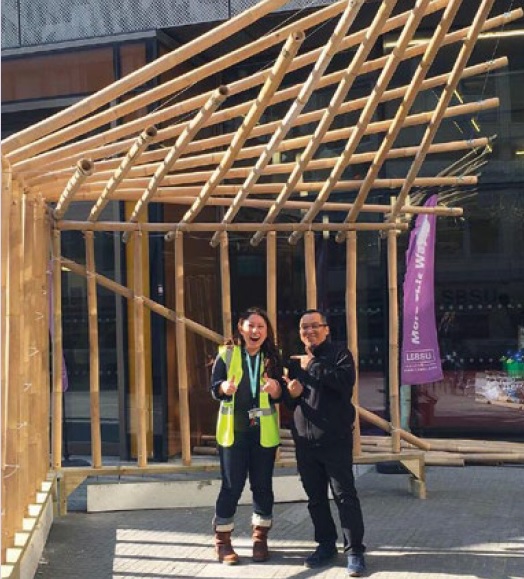Tensegrity bamboo pavilion

|
| Jennifer Hardi MCIAT, Project Leader and Programme Director at London South Bank University teamed up with bamboo architecture expert Dr Andry Widyowijatnoko and other colleagues from the Institute of Technology Bandung (ITB) Indonesia to build a temporary tensegrity bamboo pavilion. |
Contents |
[edit] Introduction
This project was a demonstration of how a sustainable material, such as bamboo, can be used to create an inspiring structure. The work is a continuation of a research-funded project through the Royal Academy of Engineering and HEFCE (now Office for Students) that Jennifer Hardi is leading. This involves multi-disciplinary collaborative working in BIM, and in designing sustainable waste recycling facilities to tackle solid waste management in a coastal tourism area in Indonesia.
The bamboo workshop was carried out at London South Bank University and, over three days, 40 students and 10 colleagues from various disciplines, ranging from architectural technology, architectural engineering, structural engineering, building surveying, civil engineering, construction management and research enterprise team, joined forces to lend a hand and provide some emotional support in building the bamboo pavilion.
With the confirmation of design received only two weeks before the D-Day for construction, clear communication and multi-disciplinary collaborative working played a crucial role in making sure the project was delivered on time.
The first challenge occurred when a decision had to be made on the most robust foundation for the temporary structure. A concrete foundation was proposed. But with such short available, plus the health and safety issues of getting the concrete to cure in that time, and transportation to the site (right next to the Student Union bar), this was not deemed to be an ideal solution.

|
The second proposal was to use a thick steel beam as the foundation for the structure but due to budget constraints this was quickly set aside. A third most feasible and sustainable solution was to re-use/re-purpose a concrete testing beam available in the engineering lab as the foundation for the bamboo structure.
Day two of the bamboo workshop saw further work done on the tensegrity roof and its supporting columns. The bamboo grid was secured in place initially with tape before the steel wires were applied onto each pole.
Day three was the biggest challenge in terms of raising the tensegrity bamboo roof onto the supporting bamboo poles. With a forklift being out of the question due to the difficulty in lifting the bamboo roof while maintaining its stability, a decision was made to rely solely on brute strength.
[edit] About Tensegrity Structure
Tensegrity is an abbreviation of tensile and integrity. It is also known as tensional integrity or floating compression, with structural principles based on the use of isolated components in compression inside a net of continuous tension. In this way, the compressed members do not touch each other and the pre-stressed tensioned members delineate the system spatially.
The picture to the right shows the tensegrity design of the bamboo pavilion by Dr Andry Widyowijatnoko that was built at London South Bank University. The core tensegrity roof was supported with bamboo columns, timber base and re-purpose concrete beam as foundation for the structure.
A tensegrity structure comprises tension and compression members where the compression members do not connect with each other. Metal wire was used in this design to act as the tension member while the bamboo poles were used as compression members. Wires were strengthened in the construction process to provide a rigid and stable structure.
[edit] Project data
Bamboo Pavilion Structure constructed in March 2019,
Designed by: Andry Widyowijatnoko, Institute of Technology, Bandung, Indonesia.
Project Leader: Jennifer Hardi, London South Bank University, UK.
[edit] About this article
This article was written by Jennifer Hardi, BSc (Hons) PGCHE MPhil SFHEA MCIAT. It previously appeared in CIAT’s AT Journal, Issue No. 130, Summer 2019 and can be accessed HERE.
More articles by CIAT on Designing Buildings can be accessed HERE.
[edit] Related articles on Designing Buildings
- Anticlastic.
- Biaxial bending.
- Buckminster Fuller.
- Geodesic dome.
- Hyperbolic paraboloid.
- Long span roof.
- Megastructure.
- Pavilion.
- Synclastic.
- Tensile strength.
- Tensile structures.
- The development of structural membranes.
- The history of fabric structures.
- Verticality.
--CIAT
Featured articles and news
RTPI leader to become new CIOB Chief Executive Officer
Dr Victoria Hills MRTPI, FICE to take over after Caroline Gumble’s departure.
Social and affordable housing, a long term plan for delivery
The “Delivering a Decade of Renewal for Social and Affordable Housing” strategy sets out future path.
A change to adoptive architecture
Effects of global weather warming on architectural detailing, material choice and human interaction.
The proposed publicly owned and backed subsidiary of Homes England, to facilitate new homes.
How big is the problem and what can we do to mitigate the effects?
Overheating guidance and tools for building designers
A number of cool guides to help with the heat.
The UK's Modern Industrial Strategy: A 10 year plan
Previous consultation criticism, current key elements and general support with some persisting reservations.
Building Safety Regulator reforms
New roles, new staff and a new fast track service pave the way for a single construction regulator.
Architectural Technologist CPDs and Communications
CIAT CPD… and how you can do it!
Cooling centres and cool spaces
Managing extreme heat in cities by directing the public to places for heat stress relief and water sources.
Winter gardens: A brief history and warm variations
Extending the season with glass in different forms and terms.
Restoring Great Yarmouth's Winter Gardens
Transforming one of the least sustainable constructions imaginable.
Construction Skills Mission Board launch sector drive
Newly formed government and industry collaboration set strategy for recruiting an additional 100,000 construction workers a year.
New Architects Code comes into effect in September 2025
ARB Architects Code of Conduct and Practice available with ongoing consultation regarding guidance.
Welsh Skills Body (Medr) launches ambitious plan
The new skills body brings together funding and regulation of tertiary education and research for the devolved nation.
Paul Gandy FCIOB announced as next CIOB President
Former Tilbury Douglas CEO takes helm.
UK Infrastructure: A 10 Year Strategy. In brief with reactions
With the National Infrastructure and Service Transformation Authority (NISTA).























